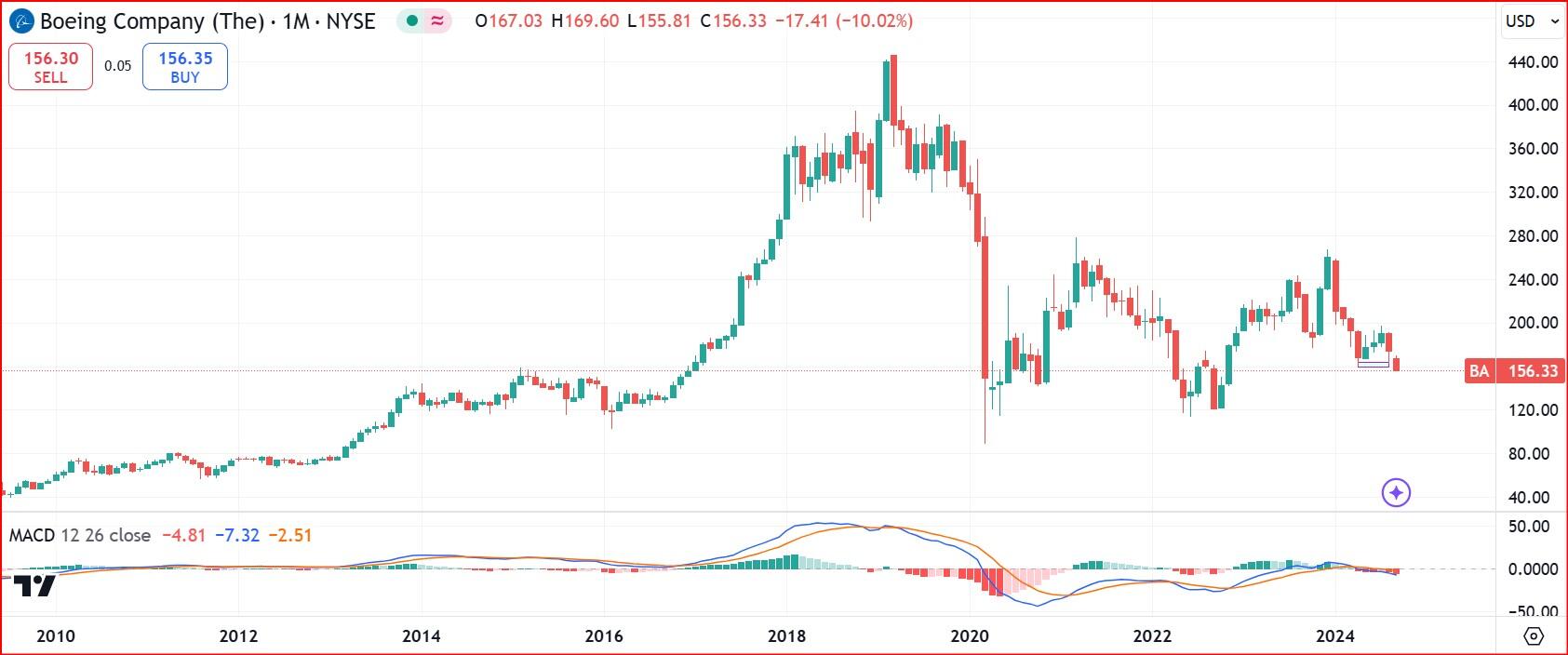- 33,000 Boeing workers walk off the job on Friday.
- Workers want a 40% increase in pay over four years.
- Wall Street trades higher as Bill Dudley calls for 50 bps cut.
- Inflation expectations fall to lowest level in eight months.
The market has reached euphoria on Friday, but Boeing (BA) is the Dow Jones stock most left out of the rally. A major strike, the first in a decade and a half, has brought further uncertainty to the aeronautics company beset by a slew of internal issues.
The Dow Jones Industrial Average (DJIA) has gained 0.9% on Friday, leading the other indices as Wall Street hopes grow for a 50 bps interest rate cut from the Federal Reserve (Fed) at the September 18 meeting next week. It was already helped along on Thursday by late-breaking Producer Price Index (PPI) data. Boeing stock is off 3.4% at the time of writing.
Boeing stock news
About 96% of Boeing’s unionized workforce voted in favor of a strike late Thursday night. There are 33,000 members of the International Association of Machinists & Aerospace Workers (IAM) at Boeing, and the union requires a two-thirds majority in order to effect a walkout.
The difference between the union and Boeing management is primarily the latter’s offer of a 25% salary raise that would be implemented over the course of four years. The union and vast majority of workers are asking for a 40% raise.
The work stoppage, the first since 2008, will affect production of the company’s 737 MAX line of airplanes and could cost the company as much as $1.5 billion if it lasts for 30 days, according to reports from CNBC.
The strike comes after years of worrying events at America’s largest exporter. Boeing has faced lawsuits and government investigations since 2018 following passenger airline crashes in Ethiopia and Indonesia.
Safety issues and the murder of an engineering whistleblower have also placed a dark cloud above the company’s prospects. Shares have shed 40% this year alone and 58% over the past five years.
Wall Street grows excited for 50 bps
Chances of a 50 bps interest rate cut next Wednesday have soared from 28% to 43% on Friday, according to data from the CME Group’s FedWatch Tool. A multitude of factors have surfaced overnight to make that the case.
In Friday’s University of Michigan Consumer Sentiment Index, the year-ahead inflation expectations fell for the fourth month in a row to 2.7%. That is the lowest level since December 2020.
Additionally, a report from the Labor Department on Friday found that import prices in August dropped by the most in eight months.
Articles in the Financial Times and The Wall Street Journal both emphasized that despite 25 bps being the mainstream expectation at next Wednesday’s Federal Open Market Committee (FOMC) meeting, it is really a tossup based on conversations among those in the know.
Former New York Fed President Bill Dudley, who is thought to be aware of current internal FOMC conversations, highlighted a “strong case” for a deeper cut. Goldman Sachs has been outspoken about the need for a 50 bps cut over the past week as well.
Boeing stock chart
Seen from a monthly chart perspective, Boeing's travails are really brought home. The best one can hope for is that the $120 level holds. That level supported price action back in 2020 and 2022.
BA monthly stock chart
Information on these pages contains forward-looking statements that involve risks and uncertainties. Markets and instruments profiled on this page are for informational purposes only and should not in any way come across as a recommendation to buy or sell in these assets. You should do your own thorough research before making any investment decisions. FXStreet does not in any way guarantee that this information is free from mistakes, errors, or material misstatements. It also does not guarantee that this information is of a timely nature. Investing in Open Markets involves a great deal of risk, including the loss of all or a portion of your investment, as well as emotional distress. All risks, losses and costs associated with investing, including total loss of principal, are your responsibility. The views and opinions expressed in this article are those of the authors and do not necessarily reflect the official policy or position of FXStreet nor its advertisers. The author will not be held responsible for information that is found at the end of links posted on this page.
If not otherwise explicitly mentioned in the body of the article, at the time of writing, the author has no position in any stock mentioned in this article and no business relationship with any company mentioned. The author has not received compensation for writing this article, other than from FXStreet.
FXStreet and the author do not provide personalized recommendations. The author makes no representations as to the accuracy, completeness, or suitability of this information. FXStreet and the author will not be liable for any errors, omissions or any losses, injuries or damages arising from this information and its display or use. Errors and omissions excepted.
The author and FXStreet are not registered investment advisors and nothing in this article is intended to be investment advice.
Recommended content
Editors’ Picks

Gold price conquers $3,100 for the first time ever on tariff war fears
The record rally in Gold price remains unabated as buyers conquer the $3,100 threshold for the time on record. Heightening fears of a potential global trade war and stagflation in the United States intensify safe-haven demand for the traditional store of value, Gold.

USD/JPY extends the slide to test 149.00 as trade war fears ramp up risk aversion
USD/JPY extends losses to test 149.00 in Monday's Asian trading. Hawkish BoJ expectations and the risk-off mood amid rising trade tensions underpin the safe-haven Japnese Yen. Moreover, fears of stagflation in the US keep the US Dollar undermined, adding to the pair's downslide.

AUD/USD clings to recovery gains near 0.6300 after China's NBS PMIs
AUD/USD is holding its rebound at around 0.6300 in the Asian session on Monday. Mixed Chinese NBS March PMI data, Australia's hot private inflation data and broad US Dollar weakness help the latest upswing in the pair. But the further upside appears limited due to Trump's tariff concerns.

Week ahead: US NFP and Eurozone CPI awaited as tariff war heats up, RBA meets
Trump’s reciprocal tariffs could spur more chaos. US jobs report might show DOGE impact on labour market. Eurozone inflation will be vital for ECB bets as April cut uncertain. RBA to likely hold rates; Canadian jobs, BoJ Tankan survey also on tap.

US: Trump's 'Liberation day' – What to expect?
Trump has so far enacted tariff changes that have lifted the trade-weighted average tariff rate on all US imports by around 5.5-6.0%-points. While re-rerouting of trade will decrease the effectiveness of tariffs over time, the current level is already close to the highest since the second world war.

The Best brokers to trade EUR/USD
SPONSORED Discover the top brokers for trading EUR/USD in 2025. Our list features brokers with competitive spreads, fast execution, and powerful platforms. Whether you're a beginner or an expert, find the right partner to navigate the dynamic Forex market.
